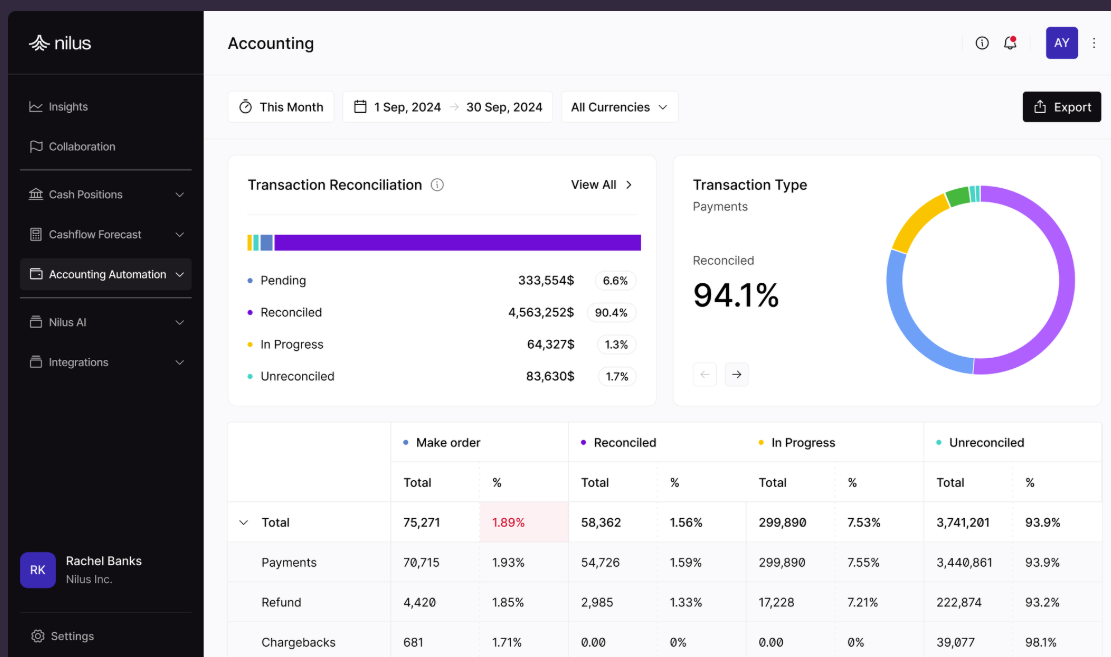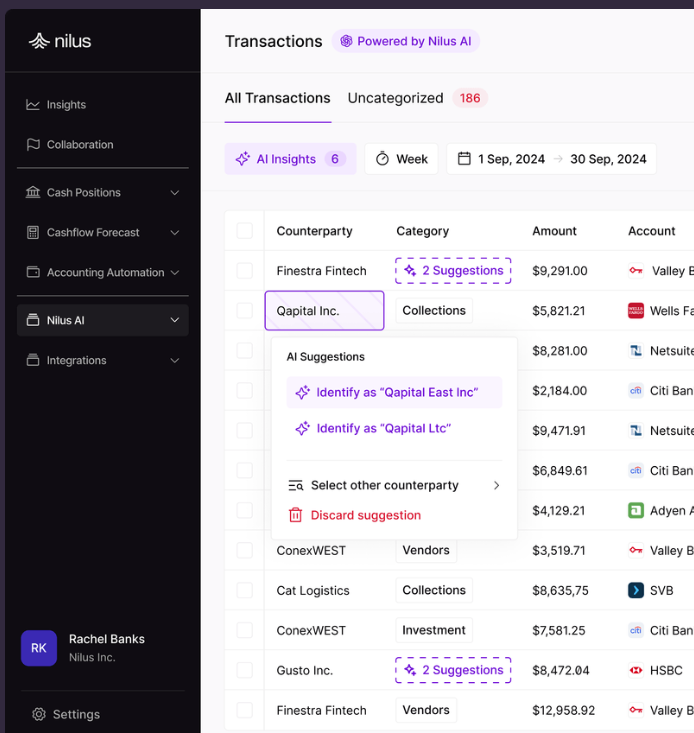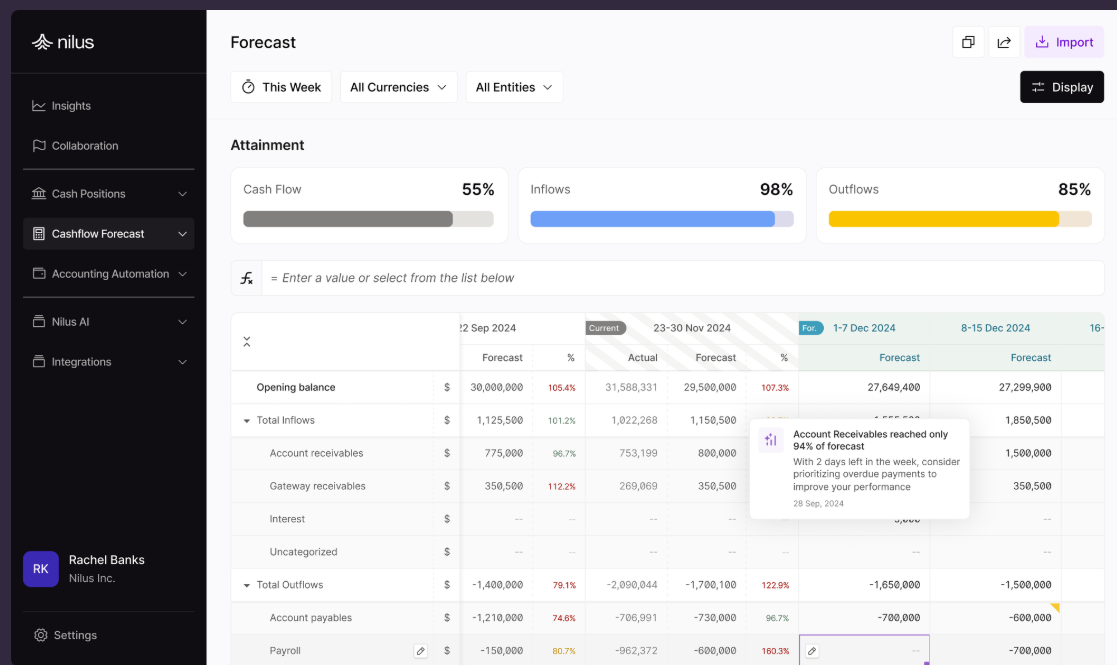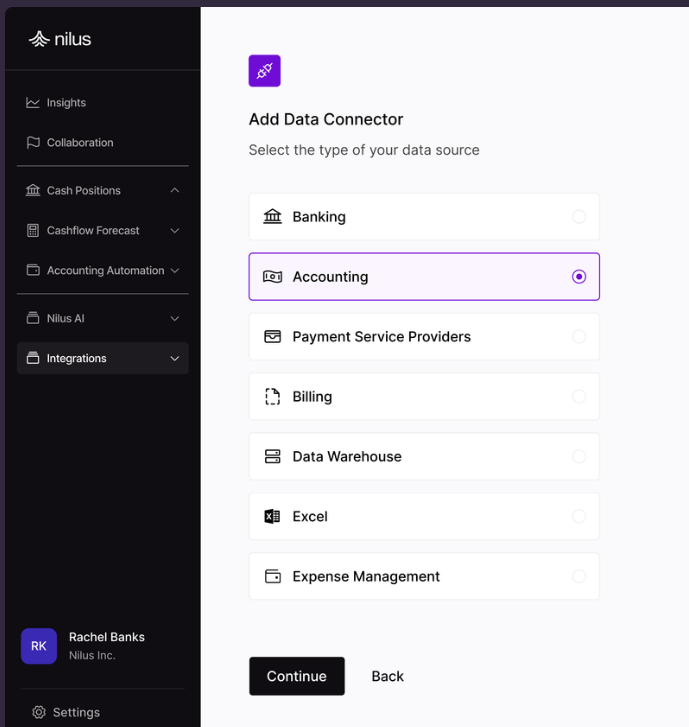Top 10 Ways AI Is Transforming Treasury Operations

Treasury teams play a critical role in maintaining a company’s financial health, from managing cash (because cash is still king) to liquidity, investments, banking relationships, and ultimately balancing risk/reward decisions.
Historically, treasury operations have been cumbersome to execute - think manual processes, data silos and decisions being made after the fact. These manual processes will lead to slow reporting and little to no advance warning to potential issues that could be lurking. Many treasury teams still operate in this manner today - yes, even in 2025.
That being said, we are seeing a transformational shift in the world of treasury operations that is changing the lives of treasurers and finance teams alike—and this shift is happening right now. Gone are the days of manually logging into bank accounts to confirm balances and transactions, or of manually reviewing transactions to detect anomalies. Now, those GIANT spreadsheets riddled with stale assumptions (and sometimes errors) to forecast cash are becoming redundant in the wake of predictive cashflow forecasting.
Spotlight: See how Allow achieves 50 hours saved monthly and unlocks critical cash decisions here.
AI is not replacing the treasury function; instead it is enabling treasury functions to operate more efficiently and effectively. Armed with insights (not just data), treasury teams can now focus their time and energy into critical decision making, vs data gathering, scrubbing and processing transactions manually.
In this blog post, we’ll explore the Top 10 ways AI is transforming treasury operations across the world and how treasury teams can take advantage of this to scale treasury operations as they look ahead to 2030 and beyond.
1. Bank Account Management
By leveraging AI solutions, treasury teams no longer need to manage bank accounts manually. For smaller companies this may still be manageable, but for companies operating across multiple countries or regions it is no longer feasible to manage associated bank accounts one by one.
Bank account balances can be monitored from a single source, connecting directly with global banks. With many companies diversifying their banking relationships (even more so in the wake of the Silicon Valley Bank collapse) it is becoming essential to have a single place to manage accounts across all banking partners. Treasury teams are also leveraging this functionality to minimize, with the view to eliminate, bank accounts running into an overdraft position.
Not only can bank account balances be managed with ease, but bank account reconciliations are no longer a painful matching exercise. With AI-first treasury tools such as Nilus, manual reconciliations are a thing of the past. For companies that process a significant number of banking transactions daily, the idea of automated bank reconciliations is no longer a “nice to have”, but an essential part in enabling treasury teams. To facilitate this process, transactions need to be tagged appropriately.
Spotlight: See how Made In cut reconciliation time by 85% here.

Screenshot from Nilus showing how you can perform your repetitive treasury and reconciliation workflows in a fraction of the time.
2. Transaction Tagging
Categorizing transactions manually is a thing of the past. Now, AI solutions offer the ability to automatically tag transactions based upon mapping rules and historical tagging. This not only streamlines the reconciliation process, but also supports expedited forecast vs actual reporting.
As with any solution that leverages AI, the outputs from these solutions are only as good as the inputs it receives. With that, there is often the need to tag some proportion of historical data in order to achieve close to 100% automation moving forward, effectively augmenting the data inputs into the process. The volume of historical data tagged will drive how quickly a treasury team can get close to 100% automation, so you need to strike the right balance.
Recommendation: Tag 6-12 months worth of transactions, if possible. The upfront lift has a short payback.

Screenshot from Nilus showing how you can perform your repetitive treasury and reconciliation workflows in a fraction of the time.
3. Cashflow Forecasting
Critical for businesses of all sizes. Small businesses often need to manage cashflow tightly to support day-to-day operations. Larger businesses will often be looking for ways to employ excess cash to generate the best return within an acceptable level of risk.
As critical as this function is, it has been traditionally error-prone and challenging to maintain as assumptions change. Now, AI models are able to seamlessly integrate with your ERP and bank accounts, reflect on customer payment history, and even consider broader macro signals to produce an accurate cashflow forecast. As actuals roll in, the forecast rolls forward and adjusts accordingly. AI is giving treasurers confidence in the execution of their cashflow forecast, allowing more time to consider scenario planning or “what if” analysis.

Screenshot from Nilus showing how you can connect your historical cash flows with your future transactions across all systems.
4. Real-time “What If” Analysis
Empowering treasury teams to perform realtime scenario planning is one of the many benefits AI is unlocking in the treasury operations world. Treasury teams can quickly assess different scenarios and stress test them to consider interest rate hikes, currency swings and other liquidity impacting events.
Taking this one step further, imagine having access to an AI-powered treasury assistant that can answer questions such as “What is our current cash position in North America today?” or “What will our cash position look like in 6 months if interest rates drop 0.5%?”
AI is changing how treasury teams interact with their data by providing real-time insights and providing scenario planning analysis in a matter of seconds.
Spotlight: See how Flare improved its cash reporting to aid better, realtime decision making here.
5. Anomaly and Fraud Detection
How can AI help treasury teams sleep better at night? With AI-driven anomaly detection, it can flag potential fraud attempts, duplicate payments, and even identify payments that would fall out of compliance with an internal policy.
Unlike static IF/THEN rules, machine learning evolves over time by identifying new patterns and keeping treasury teams sleeping safe and sound knowing that potential issues will be flagged for their review in real time.
6. Currency Risk Management
For treasury teams supporting companies operating globally, managing FX risk and hedging against it are core services offered. With the volatility we continue to see in the FX markets, it continues to be top of mind for treasurers of global companies.
AI solutions can monitor FX markets to identify big swings that could be impactful to a business and forecast expected currency exposures. With these details, some treasury teams are leveraging AI Agents to execute FX Swaps and FX forwards, based upon volatility seen in the market and the company’s appetite for FX exposure (risk).
With this, AI is driving direct cost savings to businesses that are capitalizing on the technology to drive quicker decisions and quicker execution against those decisions.
7. Liquidity
Treasury teams are leveraging AI to integrate data from their ERP with the goal of minimizing idle cash. With AR, AP and additional data points (e.g. vendor and customer payment patterns), AI solutions are offering ways to optimize liquidity buffers, without companies having to take unnecessary risks.
Balancing idle cash with the risk of running into an overdraft position is a constant battle for treasury teams. While AI has not eliminated this battle, it is setting treasury teams up for success by supporting prospective vs reactive decision making.

Screenshot from Nilus showing how you can seamlessly integrate with your banks, ERP and any financial system.
8. Intercompany Netting and Settlement
Global businesses will often have more complex intercompany payments to be managed, including repatriation of cash from one country to another. These typically involve highly manual calculations and can have significant tax implications if not managed effectively.
AI solutions are now recommending settlement strategies that are saving companies time and effort, ultimately reducing FX exposure. These solutions can model tax implications and consider local regulatory constraints such as the limitation of repatriated cash to the distributable reserves of the company.
The ability to move quickly on the repatriation of funds often depends on the coordination of multiple teams and documentation. AI is enabling the centralization of these processes, by having a single source of truth across all regions.
9. Investment Portfolio Management
Not all treasury teams manage their investment portfolio internally; some opt for asset managers to have ownership of this. This will come at a cost, e.g. % assets under management (AUM).
AI solutions are enabling treasury teams to manage their portfolio in-house by analyzing interest rate movements, credit ratings, and liquidity needs, and by making recommendations for optimal capital allocation across different investment vehicles. These same solutions can be tailored to adopt strict investment policies that align with a business’s short and long-term goals.
10. Credit Risk Monitoring
Risk monitoring is a key component of the treasury function. The treasury team depends on multiple banks, vendors, and other financial partners to ensure the stability and access to liquid funds. This has traditionally been done by following market data, reviewing credit rating reports from rating agencies and reviewing financial statements.
Successful teams are now leveraging AI to continuously scan for these artifacts and provide an early warning signal when there is risk of credit decline. By being proactive, treasury teams can avoid disaster (think back to Silicon Valley Bank in March 2023.)
Top 10 checklist
Here are the Top 10 ways AI is transforming treasury operations, summarized with a few simple bullet points.
- Bank account management - balance monitoring and reconciliation automation
- Transaction tagging - facilitate reconciliation automation via smart tagging solutions to categorize payments into predefined buckets, e.g. payroll, taxes, AP, intercompany, etc.
- Cashflow forecasting - consolidate data sources (ERP, banks, customer payment patterns, etc) to produce accurate, continuously improving forecasts
- Real-time “what if” analysis - the ability to run dynamic scenario planning enables treasury teams to offer strategic insights by quantifying the impact on liquidity and profitability across numerous scenarios
- Anomaly and fraud detection - unusual transactions can be flagged in real time to prevent potential fraud, duplicate payments, or even policy breaches
- Currency risk management - live monitoring of FX markets, combined with FX exposures, to propose (or even execute) swaps or forwards to minimize volatility
- Liquidity - minimize idle cash by monitoring AP and AR balances, as well as other payment patterns to ensure minimal cash is kept in hand
- Intercompany netting and settlement - AI can streamline this process by predicting timing issues and recommending settlement strategies. Can also support cash repatriation recommendations, considering all account balances, e.g. distributable reserves
- Investment portfolio management - live monitoring of interest rates, credit ratings and liquidity, supporting recommendations for capital allocation in compliance with predefined policies
- Credit risk monitoring - AI can monitor news events, financial statements and other signals to provide an early warning of credit declines. Proactive monitoring can help companies avoid disaster (think back to Silicon Valley Bank in March 2023.)
Final Thoughts
The treasury function is evolving. The goal now is to advance the treasury function from being a reactive, back office function into more of a strategic enabler that can drive business value and minimize waste. AI is front and center of this evolution. Treasury teams adopting AI early have a clear advantage in driving business value through more efficient and effective processes, minimizing risk and cutting waste.
Is your team ready for the next evolution of treasury operations? Ask yourself these 10 questions before choosing an AI treasury platform.
Your next treasury move is waiting
Get an ROI assessment, and find out where you’re leaving cash on the table.

Your next treasury move is waiting
Get an ROI assessment, and find out where you’re leaving cash on the table.

More Resources
Your next treasury move is waiting
Get an ROI assessment, and find out
where you’re leaving cash on the table.







